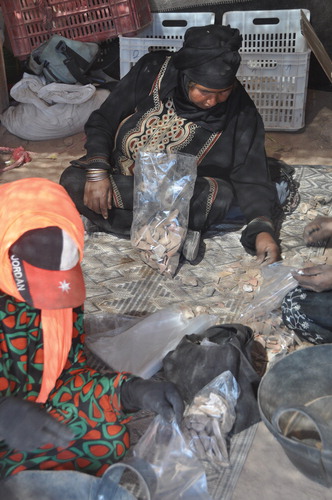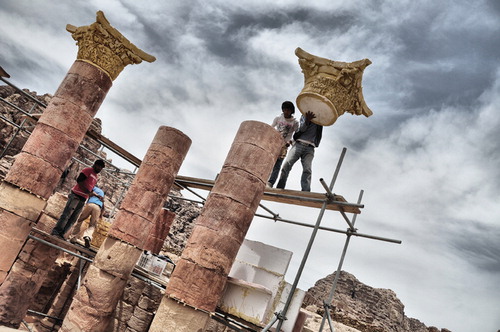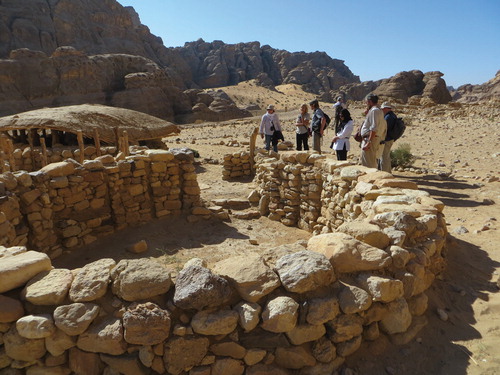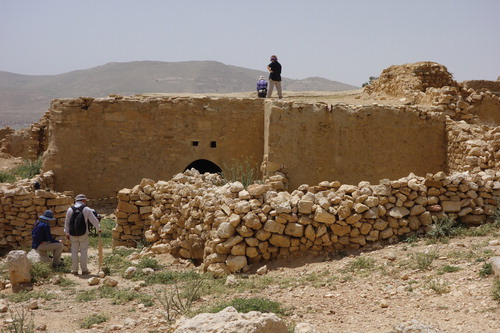Abstract
The growing influence of Public Archaeology from within the discipline and the agendas of government, international organizations and funders from outside it mean there are increasing expectations that archaeologists will mobilize archaeological resources and knowledge to directly benefit present and future generations. As a result, archaeologists are encouraged to contribute to development agendas and are becoming increasingly involved in projects featuring local economic benefits and tourism. Such projects usually require skills and perspectives which go outside archaeologists’ traditional education, and are often challenging undertakings. International institutes, including the Council for British Research in the Levant (CBRL) in Jordan, are well placed to respond to these challenging requirements in their role as facilitators of research and researchers. International institutes are fundamental in helping archaeologists to realize the potential of their work to support these agendas while maintaining their academic identity.
Public Archaeology, Impact and Development
Public Archaeology, its inception traditionally dated to changing attitudes to the plurality of views of archaeology through the 1970s and 1980s, has expanded more recently. In particular, definitions of it have grown from ones that described fairly passive studies of archaeology conducted on behalf of the public, or where the public interacts with the results of archaeological research, to ones which are more dynamic and involved. This change in orientation is captured by Matsuda and Okamura’s definition that Public Archaeology is ‘... a subject that examines the relationship between archaeology and the public, and then seeks to improve it’ (2011, 4). This definition captures a sense that simply studying archaeology, and its interaction with the public, is not enough. While still a relatively young discipline, together with a range of subjects which fall under ‘cultural heritage’, there is an increasing awareness of the role the past plays in the present. Archaeologists are increasingly faced with questions about the role the information and materials they work with play in contemporary society. As Matsuda and Okamura continue, ‘Ultimately, then, we see public archaeology as a commitment made by archaeologists to making archaeology more relevant to contemporary society’ (2011, 4).
This change in perspective within Public Archaeology also reflects a pragmatic response to outside pressures on the discipline. In the UK, while exacerbated more recently by the financial crisis, for over 30 years there has been a debate about how the cultural sector represents and justifies itself to government to receive its public funding. This debate has encompassed concepts such as ‘intrinsic’ and ‘instrumental’ values, and various attempts to measure values in such a way as to fit into existing government decision-making protocols. Although recent attempts at representing heritage in the UK are heading in a more holistic direction, the period of national financial crisis has seen a return to a position of ‘defensive instrumentalism’ (Belfiore Citation2012), where wider social and economic benefits resulting from heritage investment and activity are used to defend budgets. These benefits are traditionally positioned in opposition to ‘intrinsic’ social and cultural values more usually associated with culture (Burtenshaw Citation2010). Whatever the relative merits and faults of these approaches, the reality is that cultural organizations are expected to demonstrate their value to society as a return on investment (although that return is not necessarily monetary). The ‘impact’ agendas now expected of university departments is one such example of this.
Such expectations are not confined to domestic spheres. International heritage organizations have been aligning themselves to global development agendas, recognizing that continued government and public support comes from demonstrating cultural heritage’s contribution to contemporary issues. UNESCO (United Nations Educational Scientific and Culture Organization), in particular, has been active in showcasing how world heritage, both tangible (traditional physical remains) and intangible (the practices, knowledge and skills of society), benefits people and in forwarding the case for a cultural element to be included in the revised Millennium Development Goals, due for renewal in 2015. It is notable that, in addition to addressing critical humanitarian objectives, a strong part of UNESCO’s Syrian Crisis Response involves the safeguarding of Syria’s cultural heritage with a view to the role of cultural heritage in establishing post-conflict ‘normalcy and social cohesion’. ‘Development’ has also been a strong theme in the recent activities of ICOMOS (International Council on Monuments and Sites) and World Monuments Fund. Development organizations, such as The World Bank and USAID (United States Agency for International Development), are increasingly recognizing the value of cultural heritage in their goals. Equally, organizations like the Global Heritage Fund and the Sustainable Preservation Initiative use the capacity of cultural heritage to support local sustainable development, to attract funders and create value for archaeology on the ground and in the community.
As a result, archaeologists are expected to contribute to development projects and make the archaeology they work with ‘useful’ to people and society more broadly. Development is, of course, a vague term, usually coupled with the term ‘sustainable’ and often associated with purely economic growth, although in reality it encompasses any enhancement of quality of life without—as the ‘Brundtland’ Report established—harming the capacity of future generations to enhance their own using the same resources. The role that archaeology and cultural heritage, in combination, has in sustainable development has been increasingly acknowledged within the profession (Girard and Nijkamp 2009). Archaeology contributes to sustainable development, and wider well-being, through a variety of means, including the contribution it makes to understanding past environments and sustenance practices to inform current farming and husbandry; through the understanding of past relations between people to help social relations in the present; through providing aesthetically and culturally pleasing urban and non-urban landscapes; and of course through economic benefits. The latter is overwhelmingly associated with archaeology’s ability to act as a tourism attraction which people will pay to visit and purchase services and souvenirs associated with that visit. However, the contribution of archaeological project spends, commercial marketing utilizing archaeological sites and, of course, direct sales of artefacts (legal or illegal - ‘looting’) can also be significant.
Archaeologists themselves engage with projects involving local development in the locations where they work. This can be driven by a variety of factors, including reaction to the agendas outlined above for project and career recognition, appeasement of local communities to be allowed to conduct research, or as an incentive to cease looting or vandalism of local archaeology. Also involved are ethical and moral considerations with respect to local hosts and an imperative to ‘give something back’ and transform the excavations and the subsequent sites and data into assets which provide local communities with a useful and accessible resource—whether it be an economic, social or cultural one. This is especially true in some developing countries where there is a mis-match between the resources available to foreign archaeologists and states relative to local socio-economic reality.
While the motivations to conduct such projects are more prevalent, archaeology has not caught up in the ethics, skills and experience necessary to conduct and sustain them (Gould and Burtenshaw forthcoming). Local heritage and eco-tourism projects, for example, can require a range of data outside understanding the archaeological site itself that require a great deal of time and patience to bring to completion, with many projects taking years to reach fruition (). Collecting and dealing with such information requires skills such as economic analysis, as well as public survey and qualitative data methods. Unfortunately, there are many examples of well-meaning site museums and presentations of archaeological sites which remain empty and an economic and physical burden on local communities they were designed to help. This does not mean that archaeologists should not attempt such projects. Rather they need to realize the range of skills that are required, the need for planning and data to inform plans, and the transfer of experiences among archaeologists and other stakeholders to learn from the successes and failures of previous projects.
Fig. 1:. Khaled Khawaldeh gives a presentation on the principles and work of the Dana Cooperative at the ‘Secrets of Tafileh: local assets for community empowerment and development’ conference, 2 April 2014. This community based project builds on the success of the Dana Biosphere Reserve as an eco-tourism destination. Photo: Firas Bqa’in

International Institutes, Development and Jordan
The change in the context in which archaeological research takes place is relevant to international institutes such as the Council for British Research in the Levant (CBRL) and other international ‘schools’ of archaeology, traditionally sponsored by European and North American countries. In the case of UK institutions, they receive the pressures of a domestic academic institution to respond to the impact and cost-benefit agendas as described above. Equally, they may be seen as equated with international cultural organizations which are adopting a more development-orientated approach. Just as significant are pressures from host countries and communities to be seen to contribute to their hosts’ well-being in a post-colonial world. The relationships that these schools establish are now seen as ones which must be mutually beneficial to permit a viable longer-term presence.
International institutes have, of course, traditionally hosted a variety of international academic projects, with the CBRL hosting several valuable expeditions in its and its antecedents’ history. CBRL offers a variety of services—from the practical arrangements of logistics, bureaucracy and equipment—to the academic resources of a library and fellow experts, as well as providing a vibrant and supportive community for researchers that represents the home country in a good light. CBRL furthermore exemplifies a long-term trend in international institutes to broaden their fields of study beyond traditional archaeological and historical remits. This broader remit was explicitly incorporated into CBRL’s mandate in the late 1990s when the CBRL came into existence. The CBRL was created at that time following a review conducted by its main sponsor, the British Academy, and partly reflects the political optimism that held sway around the time of the Oslo Peace Accords. These conditions brought together the British Institute at Amman for Archaeology and History (BIAAH), now the British Institute in Amman, and the older British School of Archaeology in Jerusalem (BSAJ), since 2001 the Kenyon Institute, with its roots in the British mandate period, under one organizational ‘umbrella’. Such organizational shifts run alongside enormous changes in the host societies in which international institutes operate. In Jordan, the CBRL British Institute in Amman continues to support and conduct a wide range of archaeological research, working closely with the Department of Antiquities, and through this and other research into the broad range of disciplines it supports, is necessarily and intimately aware of local developments. These rapidly evolving local conditions impose practical, as well as moral and ethical obligations and constraints, but also new opportunities for collaboration. As the demands on archaeological expeditions change, institutes like the CBRL are well-placed to adapt and offer new services.
Specifically in terms of the archaeology and tourism projects, such international institutions can perform a valuable role. They provide a forum for the myriad expertise needed to organize and administer successful development projects based on a broad humanities and social sciences remit. Public Archaeology projects, including community-led sustainable heritage tourism projects, require not just knowledge of the local archaeology but also intimate knowledge of local socio-political and subsistence conditions, economics, politics and markets, that bridge disciplinary methods employed in anthropology, political science, geography, economics and archaeology. International institutes encourage mixing of approaches and can therefore provide a place for multi-disciplinary teams to meet and discuss and exchange ideas. Equally, projects require not only detailed knowledge of local conditions, attitudes and politics, but also practical, on-the-ground connections and know-how. The local links which permanent institutes foster over time are invaluable to archaeologists undertaking such endeavours, and indeed institutes can be thought of in many places as ‘embedded’ stakeholders, a role valued by many heritage development organizations, including the Sustainable Preservation Initiative. Equally, permanent institutes develop links with development interests and expertise in the host and home countries, allowing access to varied guidance and funding that provides for co-ordination of necessary partnerships. They can also provide the incentives and research agendas to encourage researchers in these directions, providing them with the necessary support and skills to manage such projects.
A key question to address is the relationship between these new agendas and the traditional research roles of international institutes. In response, it should be emphasized that cultural heritage’s ability to contribute to development is rooted in research. Archaeological research (of a wide variety) provides the understanding of sites, landscape, past environments, past lifestyles and past peoples which tell the stories that capture the imagination of the public, motivates them to visit, and provides the social relevance and cultural inspiration to local people today. A key ingredient is the plurality of the research. For example, aspects of the past can often be difficult for the public to relate to, but the exploration of intangible elements of cultural heritage through approaches such as ethnoarchaeology, or the use of cross-cutting themes like environmental archaeology can increase the relevance of the past for people and bring value to all periods of the past that is present around them. Just as the contribution to development agendas provides the awareness and funding to support research, it must be remembered that research—and, vitally, its dissemination—provides archaeologists with the material and perspectives to contribute to these agendas. International institutes, through the range of activities they host, nurture and support this symbiotic relationship.
Of course, Public Archaeology initiatives involving both domestic and foreign archaeologists have happened before in Jordan and are happening today, often connected to and incubated by international institutes (for a recent summary covering some of these project see Near Eastern Archaeology 2013). Some of the more notable examples include the American Centre for Oriental Research’s (ACOR) Temple of the Winged Lions project (TWLCRM, , ), which is taking an innovative approach to local employment and impact (Tuttle Citation2013), Dino Politis’ pioneering work in Safi and the establishment of the Museum at the Lowest Point on Earth (Politis Citation2009), and former ACOR Director Bert De Vries’ long-term archaeological mission and community engagement programme at Umm el-Jimal (www.ummeljimal.org). And, of course, some twenty plus years ago, the anthropological groundwork of former BIAAH director, William Lancaster and his wife, Fidelity, in the Wadi Faynan region, followed by the far-sightedness of another former BIAAH/CBRL Director, Alison McQuitty, whose efforts in nurturing and promoting the Wadi Faynan Project began a strong relationship for CBRL with the people of that area that continues to this day and that forms the basis for continuing projects. Elsewhere, restoration and site presentation at early Islamic palaces has built up local expertise and contributed to the development of these sites as tourist attractions, including projects conducted by the Spanish Mission, under the direction of Ignacio Arce, at the Amman Citadel and Qasr Hallabat (also pre-Islamic), and Berlin Institute of Technology and Berlin National Museums’ site management programme at Qasr al-Mushatta. Bill Finlayson, representing the CBRL, has a long-term agreement with the Petra Park Authority and USAID in developing the iconic Neolithic settlement of Beidha excavated initially by Diana Kirkbride, combining skills in site presentation and management () alongside research (Flohr and Finlayson Citation2013). In addition, the Epipalaeolithic Foragers in Azraq Project (EFAP) team with CBRL and in partnership with the Department of Antiquities has worked at Azraq, achieving notable success in integrating the local community into archaeological investigations and developing the sites as part of local social capital (Damick Citation2011). Equally, archaeologists are interacting with non- academic organizations, such as the Petra National Trust and the Royal Society for the Conservation of Nature (), who have engaged local communities by offering specialist knowledge or different perspectives. These projects have been the vanguard of a growing trend in Jordan for cultural heritage management to become more prominent. Recent Director-Generals of the Department of Antiquities, including the present Director-General, Dr Monther Dahash Jamhawi, reflect the global trends and encourage more public connections to archaeology to foster a more fruitful relationship with tourism than has been possible in Jordan’s recent history. The recent conference ‘Secrets of Tafileh: Local Assets for Community Empowerment and Development’, organized between the Ministry of Tourism and Antiquities and the CBRL in April 2014, is an example of this trend (). The conference sought how the under- appreciated heritage assets of the area could be mobilized for community and local-led tourism through combining strong local involvement with international advice and perspectives.
Fig. 2:. Women from the TWLCRM local team bag pottery recovered during the sifting of the large dumps produced by the original AEP excavation. One goal of the TWLCRM social engagement program is to train local women to identify and process the thousands of sherds recovered from the AEP dumps. Photo: Ghaieth Al Faqeer

Fig. 3:. TWLCRM team members place ‘faux restoration’ columns and capitals made of lightweight materials in the temple’s cella. Through this experiment, the team was able to test how the columns would look as part of the project’s final presentation strategy for the monument. Image: Qais Tweissi

CBRL is pressing on with a research agenda to develop the skills and data necessary to prepare for the reality of using archaeology in this way. The new INEA (Identifying activity areas in Neolithic sites through Ethnographic analysis of phytoliths and geochemical residues) project between CBRL and Bournemouth University and its antecedents (e.g. Palmer et al. Citation2007 at Wadi Faynan) seek to understand traditional lifeways and communities, gaining valuable insights into the current and recent social history of Jordan and its peoples, but also using the knowledge gained to understand other archaeological periods that create a link between existing and past communities. INEA recently completed fieldwork in the Tafileh area immediately following the Tafileh conference (). CBRL’s newly launched DEEPSAL (The Deep Past as a Social Asset in the Levant) project will provide in-depth data on how different communities in Jordan relate to local Neolithic heritage, incorporating existing interests at Wadi Faynan and Beidha to develop a Neolithic Heritage Trail (, ). This will include understanding how sites currently contribute to the economic, social and cultural well-being of these communities, and the socio- economic and political context within which this contribution takes place. The project will work with these communities over one year and the subsequent understanding will provide a rich and solid foundation upon which to base future Public Archaeology and development programmes, ensuring that the they have the maximum chance of success to benefit the archaeological sites and the local communities themselves.
Fig. 4:. Visitors discussing the reconstructed neolithic structures at Beidha, near Petra—a site on the proposed Neolithic Heritage Trail and part of the CBRL’s DEEPSAL project. Photo: Carol Palmer

Conclusions
A variety of factors are converging to change the expectations that archaeologists and stakeholders have of the work and goals of archaeological research. In Jordan, international and domestic archaeologists have been responding to that challenge with innovative projects. These projects rely on new skills, collaborations and experience which archaeology traditionally lacks. International institutes, including the CBRL, are well-placed to respond through the range of research they encourage based on long-term residence in the region. Their foundation in academic research and excellence is not a hindrance to new goals, but rather an advantage. Institutes (or councils, or schools) have the ability to combine development and research roles, and are in a unique position in this respect, separate from organizations that are purely academic or purely development-oriented. Their strength is in the symbiotic relationship between research and application. In focusing on this relationship, it is possible to act on Matsuda and Okamura’s call to both understand the relationship between the public and archaeology but also act to improve it for the benefit of all.
Note on Contributors
Paul Burtenshaw is Director, Projects of the Sustainable Preservation Initiative, having previously been a Postdoctoral Research Fellow at CBRL in Amman. Paul obtained his PhD at the Institute of Archaeology, University College London, which explored and highlighted the economic value of archaeology.
Carol Palmer is Director of the CBRL’s British Institute in Amman. She trained as an environmental archaeologist (specializing in archaeobotany) and developed anthropological expertise through extensive fieldwork in the Middle East and Jordan in particular. Her research interests range broadly on the themes of traditional and modern rural life in the Middle East, ecology, agriculture and food.
Acknowledgements
The authors are grateful to our colleague, Prof. Bill Finlayson (CBRL Director), as well as Dr Barbara A. Porter (American Centre for Oriental Research Director) and Prof. Christopher Knüsel (CBRL Senior Research Fellow), for comments on an earlier version of this paper.
References
- Belfiore, E.(2012) ‘Defensive instrumentalism’ and the legacy of New Labour’s cultural policies. Cultural Trends 21(2), 103–111.
- Burtenshaw, P.(2010) Review, Cultural Capital: A Manifesto for the Future. Public Archaeology 9(4), 239–42.
- Damick, A.(2011) Landscapes of the past: place, space, and the construction of meaning in the Azraq community archaeology project. Bulletin of the Council for British Research in the Levant 6, 28–34.
- Flohr, P. and B. Finlayson(2013) Presentation, preservation, and experimentation at Beidha, a Neolithic site in Jordan. Bulletin of the Council for British Research in the Levant 8, 59–61.
- Girard, L.G. and P. Nijkamp(eds) (2009) Cultural Tourism and Sustainable Local Development. Aldershot: Ashgate.
- Gould, P. and P. Burtenshaw (forthcoming) Guest Editorial: Archaeology and Economic Development. Public Archaeology 13, 1–3. 2013
- Near Eastern Archaeology, (2013) Special Issue on Public Archaeology: Collaborative and Community Approaches, 76(3), 128–192.
- Matsuda, A. and K. Okamura(2011) Introduction: New Perspective in Global Public Archaeology. Pp. 1–18 in K. Okamura, and A. Matsuda (eds.) New Perspectives in Global Public Archaeology. London: Springer.
- Palmer, C., Gilbertson, D., el-Rishi, H., Hunt, C., Grattan, J., McLaren, S. and B. Pyatt (2007) The Wadi Faynan today: landscape, environment, people, 25–57. In G Barker, D Gilbertson and D Mattingly (eds) Archaeology and Desertification: The Wadi Faynan Landscape Survey, southern Jordan. Wadi Faynan Series 2; Levant Supplementary Series 6. Oxford: Council for British Research in the Levant and Oxbow Books.
- Politis, K.D.(2009) The conservation and heritage management of the Sanctuary of Lot at Dayr ‘Ayn ‘Abata. Studies in the History and Archaeology of Jordan 10, 259–68.
- Tuttle, C.(2013) Preserving Petra Sustainably (One Step at a Time): The Temple of the Winged Lions Cultural Resource Management Initiative as a Step Forward. Journal of Eastern Mediterranean Archaeology and Heritage Studies 1(1), 1–23.


